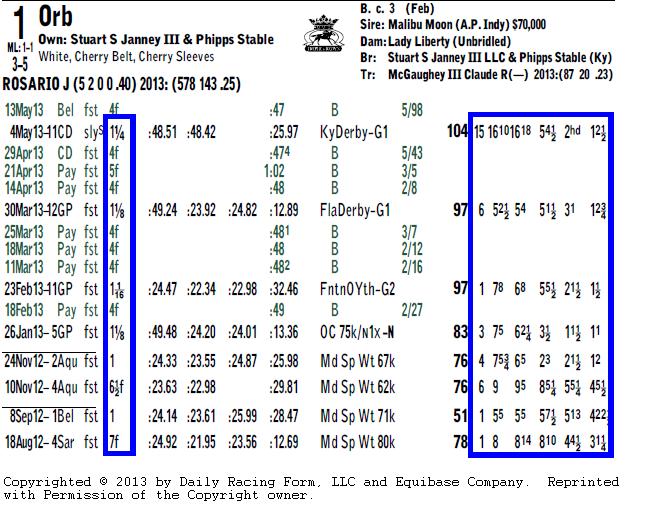Running Lines
The Running Lines appear smack dab in the middle of the Past Performances (PPs) for each horse in the Daily Racing Form. We have alluded to them already, but in this post we’ll give a full account of what they mean, and how they vary by the distance of the race. All together there are Six columns of positions for the running line of past races.
The larger number represents the relative position of the horse at a specific point in a race. The smaller number shows the number of lengths the horse was behind the leader of the race, or if the horse was in the lead, the smaller number is the number of lengths they were ahead of the 2nd place horse. The very first column shows the position the horse was in the starting gate at the beginning of the race. This number is not necessarily the same as the “betting” number for that horse in the race. A horse’s position in the gate can be affected by scratches and/or coupled horses. But, their betting number is fixed.
The following are some sample running lines that might appear in the DRF.
| Dist. | PostPos. | 1st Call | 2nd Call | 3rd Call | Stretch | Finish |
|---|---|---|---|---|---|---|
| 6f | 2 | 1 | 1 1 | 1 1 1/2 | 1 5 1/2 | 1 6 3/4 |
| 7f | 5 | 8 | 6 3 1/2 | 5 3 | 4 2 1/2 | 3 1 1/2 |
| 8f | 11 | 3 1 1/2 | 2 1 | 2 1/2 | 1 nk | 2 no |
| 10f | 15 | 16 10 | 16 18 | 5 4 1/2 | 2 hd | 1 2 1/2 |
The running lines help to provide a mental image of what happened in a horse’s prior races. Let’s reconstruct the story in each race example above.
- In the 6f race, the horse broke quickly out of the gate, jumping to the lead at the start and extending his lead at every subsequent call in the race, winning by 6 3/4 lengths at the finish. Since the horse led at every call in the race, it’s referred to as a “wire-to-wire” winner.
- In the 7f race, the horse broke a little slow (8th), but steadily improved throughout the race, gaining ground on the leader at every call, and finishing 3rd, beaten by 1 1/2 lengths.
- In the 8f race, the horse broke well from an outside post position (11), chased the leaders into the stretch, eventually taking the lead, only to get caught by another horse and lose by a nose at the finish.
- The 10f race is the actual running line for the 2013 Kentucky Derby winner Orb. He was far back at the first two calls, then made a big middle move gaining 13 1/2 lengths on the leader between the 2nd and 3rd call, sustained his move in the stretch, and pulled away at the finish winning by 2 1/2 lengths.
You may have noticed there is a slight difference on the 1st call between the Sprints (6f and 7f) and the Routes (8f and 10f). The sprints do not show any lengths information, while the routes do show it. The reason is that the position in the race for the 1st, 2nd, and 3rd calls vary slightly by the distance of the race. For Sprint races, the 1st call is the start of the race, while it is the 1/4 mile (2f) position for most route races.
Below are the PPs for Orb (prior to The Preakness) with the race distance and running lines clearly marked.

Notice there are no headings for the six positions in the running lines. But, now you know what they mean.
